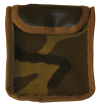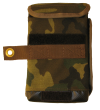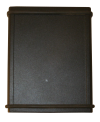![Batcorder 3 Bat Detector Batcorder 3 Bat Detector]()
Click to have a closer look
About this product
Specification
Customer reviews
Related products
Recommended products
About this product
To find out how the Batcorder System works, watch the 6 minute demonstration video. This video will revolutionise your bat work! CLICK HERE TO WATCH THE VIDEO
The Batcorder 3 is the first worldwide data recorder that distinguishes bat calls from other sound sources in real-time (online signal analysis). Calls are recorded digitally as call sequences. Thus, bat calls can easily be sampled automatically at nearly every possible location. Bush crickets and other sounds (e.g. wind, water, rustling of leaves) are under most circumstances not recorded at all. The batcorder was developed specifically to be used as an autonomous recording device in the field. It is not a conventional bat detector, and bat calls are not played over headphones or a loudspeaker. In contrast to other such devices, each batcorder and its microphone are calibrated for a fixed sensitivity. Thus, the comparison of activity recorded at different locations and with different detectors is guaranteed.
Recordings are stored on an SDHC card, with the batcorder sampling sound at 500 kHz with 16 Bit amplitude resolution. Thus, it uses 1 MB of memory per second of sound recording. A SDHC card of 16 GB of memory allows you to store around 15,000 typical bat recordings (each with approximately one second of duration). This is sufficient for activity sampling of 5 to 20 consecutive nights at most ground based locations. When recording on wind turbines, recordings of more than 30 days usually fit onto a 16GB SDHC card.
The batcorder is optimized for autonomous usage and its casing is IP65 weatherproof. Through intelligent algorithms and low-power consuming parts, the batcorder reaches run-times of up to 100 hours with the supplied, external NiMH battery pack (6V / 2.7 Ah). This typically resembles 6 to 10 nights of usage in Auto + Timer mode.
The Batcorder 3 features include;
* Calibrated sensitivity allows comparison of measurements of bat activity.
* High quality recordings (500 kHz / 16 bit) enable proper differentiation even of difficult species like Myotis.
* Unique algorithm recognizes bat calls.
* Programmable timer, threshold and trigger.
* Ergonomic and easy to use interface.
* Log file with all relevant recording information enables subsequent automatic import of the data.
Operational Settings
More details on the Batcorder can be found in the Batcorder Manual. To download a copy of the manual, please see the Specifications tab. The Batcorder can be used in three different recording settings;
Auto + Timer Mode
The batcorder starts up at a user-chosen time (usually in the evening), and starts a recording when it encounters a valid call event. It then saves the incoming sound for as long as further calls are recognized within a chosen time interval (post-trigger time). At a user-chosen time (usually in the morning) the batcorder stops sampling again and shuts down to save battery power.
Auto Mode
This mode is equivalent to the Auto + Timer mode, but the scanning for calls has to be initiated manually. The timer is deactivated and the batcorder runs until switched off again.
Manual Mode
In this recording mode the call recognition algorithm is deactivated. Recordings are started / stopped manually by pressing the Rec key.
Passive Monitoring
The batcorder is optimized for passive monitoring of bat activity. Its easy deployment and long runtime of up to ten nights makes it an ideal tool for consultants and scientists. The high omnidirectionality of the microphone and the good signal-to-noise ratio results in high quality full-spectrum recordings of bat calls. This allows the automated analysis of recordings, one of the necessities of passive monitoring due to the often large amounts of recordings.
Sound Format
Sound recordings are written as raw audio files. These files can be read with any sound software that is capable of opening raw files, including Batsound.
Find out about the key benefits of the Batcoder System here
For a brief introduction to the Batcorder system, check out the NHBS blog.
Specification
The Batcorder includes;
Batcorder
Omnidirectional microphone and extender
Camouflage cordura case for batcorder
Echo-absorber cloth (to minimise echos reflected by the batcorder)
Battery pack (NiMH 6V / 2.7Ah)
Camouflage cordura case for battery pack
Charger (110-240V) and adaptor lead
Cable to connect batcorder and battery pack
Instruction manual
Protective carry case with foam inserts for all items listed above
Measurements
Batcorder (excluding microphone): 190mm H x 105mm W x 32mm D (weight: 460g)
Microphone: 225mm long
Battery pack: 102mm H x 80mm W x 22mm D (weight: 295g)
Batcorder to battery pack cable: 300mm long
Specifications
* Sample rate: 500 kHz
* Dynamic range: 16 bit (96 dB)
* Call detection: online-analysis (quality + threshold selectable)
* Recording modus (selectable): automatic (2 Modi), manual
* Microphone: electret
* Frequency range (recorded range): 16 kHz - 150 kHz, bandpass each 10th order
* Omnidirectionality: high
* Flash memory: SDHC-Card ( 4 to 32 GB)
* Post-trigger: 0/200/400/600/800 ms
* Pre-trigger: 50 ms
* Robustness: IP65 (excludes microphone)
* RS232 interface: allows communication with third-party devices (e.g. GPS)
* Power consumption: ca. 0.25 Watt
* Power supply: 6V, 2.6 Ah (NiMH)
* Runtime: 7 to 10 nights in timer mode (battery pack provides power for up to 100 hours operating time).
Please note, does not come with an SD card.
To download a PDF of the Batcorder Manual, click here.
Customer Reviews






















































